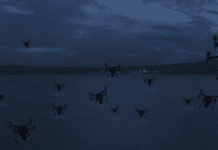This post is also available in:
 עברית (Hebrew)
עברית (Hebrew)
A new suicide UAV by the name of PD-2900 was recently unveiled in China. It has twin gasoline engines and large wings and resembles similar UAVs that are used in the Russia-Ukraine war, including the Iranian Shahed UAV, although much larger than the Shahed 136. The PD-2900 has a 12-hour flight capacity, a range of up to 2500 kilometers, and can go up to a speed of 250 km/h. Further, it displays a camouflage paint not dissimilar to the Russian Sukhoi Su-57 multirole fighter aircraft.
According to Interesting Engineering, China and Russia discussed in 2023 developing kamikaze UAVs with similar range and payload capabilities to the Shahed-136 (Russian name Geran-2), although information regarding their cooperation on the PD-2900 is unclear.
Due to their lower production costs that stem from components being available in the mass market, large-sized suicide UAVs have become a common alternative to cruise missiles in conflict, enabling military forces to use them more frequently than their more costly arsenal. This is exemplified in the Russia-Ukrainian War, as both parties used their own versions of these long-range weapons.
In terms of specs, the PD-2900’s has a carbon fiber body, enabling excellent structural integrity while still maintaining a lighter weight. It can be launched autonomously or via catapult or rocket-assisted options. It can cruise autonomously according to pre-installed routes and has a fully autonomous landing. The UAV has a payload capability of 100 kg and can fly for as long as 12 hours. It has a 160-liter fuel tank that is explosion-proof, and can reach a maximum range of 2500 km. As the UAV is comprised of three separate pieces, it can be better assembled and transported.
Previous Chinese designs supported capabilities such as real-time precise kinematic positioning for take-off and landing, a post-processing kinematic function, auto-networking, auto-relaying, and anti-frequency hopping capabilities, and so this UAV has the potential to do the same, according to Interesting Engineering.
In the past few years, there has been a significant increase in the use of UAVs, including suicide UAVs, in battle. Their low cost, varied uses, and low flight altitudes that allow for more concealed flight are all important advantages for the side controlling them. They allow for long-range, precise striking while keeping their operator protected, even beyond the country’s borders. It is likely we will see more and more advanced UAVs over the next few years.

























